
Coralline algae are red algae in the order Corallinales. They are characterized by a thallus that is hard because of calcareous deposits contained within the cell walls. The colors of these algae are most typically pink, or some other shade of red, but some species can be purple, yellow, blue, white, or gray-green. Coralline algae play an important role in the ecology of coral reefs. Sea urchins, parrot fish, and limpets and chitons feed on coralline algae. In the temperate Mediterranean Sea, coralline algae are the main builders of a typical algal reef, the Coralligène ("coralligenous"). Many are typically encrusting and rock-like, found in marine waters all over the world. Only one species lives in freshwater. Unattached specimens may form relatively smooth compact balls to warty or fruticose thalli.

Conceptacles are specialized cavities of marine and freshwater algae that contain the reproductive organs. They are situated in the receptacle and open by a small ostiole. Conceptacles are present in Corallinaceae, and Hildenbrandiales, as well as the brown Fucales. In the Fucales there is no haploid phase in the reproductive cycle and therefore no alternation of generations. The thallus is a sporophyte. The diploid plants produce male (antheridia) and female (oogonia) gametangia by meiosis. The gametes are released into the surrounding water; after fusion, the zygote settles and begins growth.
In algal anatomy, a pit connection is a hole in the septum between two algal cells, and is found only in multicellular red algae − specifically in the subphylum Eurhodophytina, except haploid Bangiales. They are often stoppered with proteinaceous "pit plugs". By contrast, many fungi contain septal pores − an unrelated phenomenon.
Phymatolithon is a genus of non geniculate coralline red algae, known from the UK, and Australia. It is encrusting, flat, and unbranched; it has tetrasporangia and bisporangia borne in multiporate conceptacles. Some of its cells bear small holes in the middle; this distinctive thallus texture is termed a "Leptophytum-type" thallus surface, and has been posited as a taxonomically informative character. It periodically sloughs off its epithallus, reducing its overgrowth by algae by as much as 50% compared to bare rock.
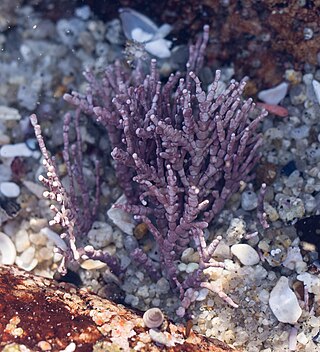
Calliarthron is a genus containing two species of thalloid intertidal alga. Specimens can reach around 30 cm in size. The thalli take a crustose form. The organisms lack secondary pit connections. Calliarthron reproduces by means of conceptacles; it produces tetraspores, dispores and carpospores. The genus has lignin and contains secondary cell walls, traits which are normally associated with the vascular plants. It is similar to the genus Bossiella.
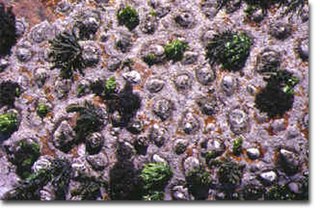
Scutellastra cochlear is a species of sea snail, a marine gastropod mollusc in the family Patellidae, one of the families of true limpets. It is commonly known as the snail patella, the pear limpet or the spoon limpet and is native to South Africa. It often grows in association with the crustose coralline alga Spongites yendoi and a filamentous red alga which it cultivates in a garden. It was first described by the malacologist Ignaz von Born in 1778 as Patella cochlear.
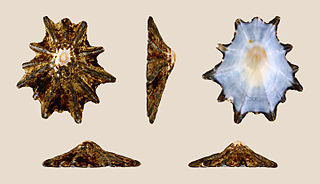
Scutellastra longicosta, the long-spined limpet or the duck's foot limpet, is a species of true limpet, a marine gastropod mollusk in the family Patellidae, one of the families of true limpets. It is native to the coasts of South Africa where it is found on the foreshore. It cultivates a species of crustose brown algae in a "garden".
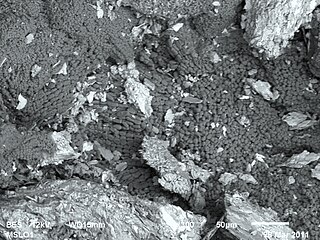
Lithophyllum is a genus of thalloid red algae belonging to the family Corallinaceae.
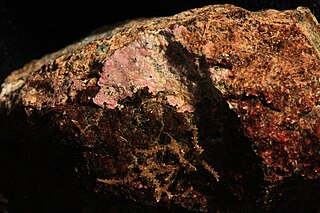
Hildenbrandia is a genus of thalloid red alga comprising about 26 species. The slow-growing, non-mineralized thalli take a crustose form. Hildenbrandia reproduces by means of conceptacles and produces tetraspores.
The epithallium or epithallus is the outer layer of a crustose coralline alga, which in some species is periodically shed to prevent organisms from attaching to and overgrowing the alga.
Synarthrophyton is a genus of thalloid red algae comprising eight species. The monomerous, crustose thalli are composed of a single system of filaments which grow close to the underlying surface. Synarthrophyton reproduces by means of flask-shaped multiporate conceptacles; it produces tetraspores and dispores. Mucus plugs the opening of young conceptacles, which open as they mature.
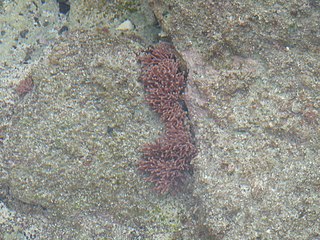
Amphiroa is a genus of thalloid red algae under the family Corallinaceae.

Ralfsia verrucosa is a species of crustose brown seaweed in the family Ralfsiaceae. It grows intertidally in temperate waters around the world. In South Africa it is part of a mutualistic relationship with a limpet.
Mastophora is a genus of thalloid alga comprising four species. The dimerous, crustose thalli comprise two groups of filaments. The bulk of the thallus is made of erect filaments, which may be one or many cells long. These grow approximately perpendicular to the filaments of a basal layer, usually one cell thick. haustoria, haustoria, and palisade cellsare present in the organisms but lack secondary pit connections. Mastophora reproduces by means of conceptacles; it produces tetraspores and dispores.

Melobesia membranacea is a small marine alga encrusting on the surface of other algae. In the division of the Rhodophyta.
Sporolithon ptychoides is a species of crustose red seaweed with a hard, calcareous skeleton in the family Corallinaceae. It has a widespread distribution, being present in the Pacific and Indian Oceans, the Mediterranean Sea and the southwestern Atlantic Ocean.

Lithophyllum orbiculatum is a species of thalloid coralline algae, which are a red algae whose cell walls contain calcareous deposits.
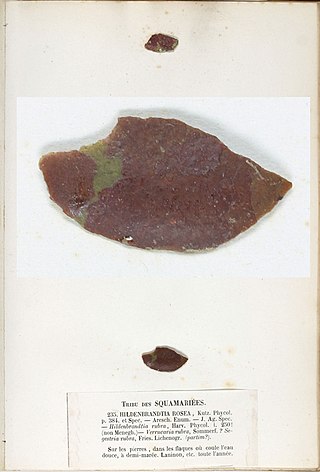
Hildenbrandia rubra is a marine species of thalloid red alga. It forms thin reddish crusts on rocks and pebbles in the intertidal zone and the shallow subtidal zone. It is a common species with a cosmopolitan distribution, and is able to tolerate a wide range of conditions.
Phymatolithon lenormandii is a common red alga.
Crustaphytum is a genus of red alga first discovered in Taoyuan algal reefs by Taiwanese scientists. The epithet “crusta” refers to crustose thallus and “phytum” refers to plant. Belonging to the family Hapalidiaceae in the order Hapalidiales, Crustaphytum is one kind of crustose coralline algae.












